Psoriasis or scaly lichenIt is a chronic disease that affects the skin and its integuments: nails and hair. It is characterized by periods of deterioration (relapses) and temporary well-being, when the manifestations of the disease subside. This disease is not contagious and the patient is not dangerous for others. Because the onset of psoriasis is not associated with microorganisms.
Psoriasis most commonly occurs between the ages of 15 and 45. People with fair skin are more sensitive to it. In developed countries, the number of patients with psoriasis reaches 2-4% of the population. Every 25th inhabitant of the earth on every continent suffers from it.
A large number of medical institutions are faced with this problem. Therefore, psoriasis has been recognized as the most studied disease. But still, this disease is not fully understood. Officially, it is considered incurable and raises many questions.
Psoriasis is caused by the body's own immune cells. They rise from the lower layers of the skin to the upper layers, causing inflammation, proliferation of epidermal cells, and the formation of small capillaries.
The manifestations of psoriasis on the skin are quite varied. Most often, the disease provokes the appearance of red spots - psoriatic plaques. They are dry to the touch, rise above the surface of the skin, and have a white coating.
Types of psoriasis
The disease is divided into two large groups: pustular and non-pustular psoriasis.
Non-pustular psoriasis
- ordinary (vulgar) or simple psoriasis (plaque psoriasis, chronic stable psoriasis)
- psoriatic erythroderma or erythrodermic psoriasis
Pustular psoriasis
- von Tsumbusch pustular psoriasis or generalized pustular psoriasis
- palmoplantar psoriasis (pustular psoriasis of the extremities, chronic persistent palmoplantar pustulosis)
- annular pustular psoriasis
- palmoplantar psoriasis
- Psoriatic impetigo herpetiformis
In addition, these types of psoriasis are distinguished.
- seborrheic psoriasis
- psoriasis of the flexor surfaces and skin folds
- Napkin Psoriasis
- drug-induced psoriasis
Depending on the severity, such forms of psoriasis are distinguished.
- Soft - less than 3% of the skin is affected.
- Moderate - 3-10% of the skin is covered with psoriatic plaques.
- Severe - there is joint damage or more than 10% of the skin is affected.
Causes of psoriasis

To date, there is no clear answer to the question: "why does psoriasis appear? "Scientists have put forward several theories.
- Psoriasis is an autoimmune disease. It is based on a dysfunction of the immune system. The immune cells of T-killers and T-helpers, whose function is to protect the body against viruses, bacteria, and tumor cells, for some reason get into the upper layers of the skin. Here, they produce inflammatory mediators - substances that "trigger" the inflammatory response. This results in increased division of skin cells and their multiplication (proliferation).
- Psoriasis is a disease caused by impaired growth, division and maturation of epithelial cells - keratinocytes. The result of such changes in the skin is an attack by the immune cells of the T lymphocytes and macrophages on the diseased skin cells.
Factors that contribute to the development of psoriasis
Doctors have noted a number of factors that can cause the onset of the disease. Of course, more often than not, psoriasis occurs if more than one of these conditions is acting on the body at the same time.
- Hereditary predisposition.There is a version that the genes responsible for the immune system and T cell function are carriers of the disease. Therefore, parents who suffer from psoriasis are more likely to have children who develop the same symptoms.
- Thin and dry skin. . . It has been noted that people with such skin features fall ill more often than those with oily, well-hydrated skin. This is probably due to the protective functions of sebum and the structural characteristics of the skin.
- External irritants. . . A high percentage of patients are those who are constantly in contact with alcoholic solutions, solvents, household chemicals, cosmetics (lotions, hand creams).
- Excessive hygiene- an excessive love of cleanliness also undermines the protective properties of the skin. Soaps, shower gels and washcloths eliminate the natural protective barrier and leave microscopic wounds.
- Bad habits- addiction to alcohol, tobacco and drugs is bad for the skin. His nutrition and blood supply are deteriorating.
- HIV- AIDS patients are more prone to psoriasis. Scientists cannot explain this phenomenon. The fact is that psoriasis is caused by increased activity of lymphocytes, and with AIDS their number decreases.
- Medications- taking certain medications can cause illness. Among them: beta-blockers, antidepressants, anticonvulsants and antimalarials, lithium carbonate.
- Infections (fungi and staphylococci). . . Quite often there have been cases when psoriasis appeared immediately after fungal infections or diseases caused by streptococcus.
- Moving- a change in climate or even a season of the year, environmental degradation can be a trigger for this disease.
- Stress- strong emotional or physical upheavals (prolonged periods of hypothermia, overheating, accidents) precede the appearance of the first symptoms of psoriasis.
- Trauma- constant effect on the skin: pressure, friction, scratching. Such regular trauma can cause the first psoriatic plaques to appear in this area.
- Allergic conditions- Allergic rashes and the processes that occur in this case in all layers of the skin also increase the risk of disease.
What are the symptoms and signs of psoriasis?
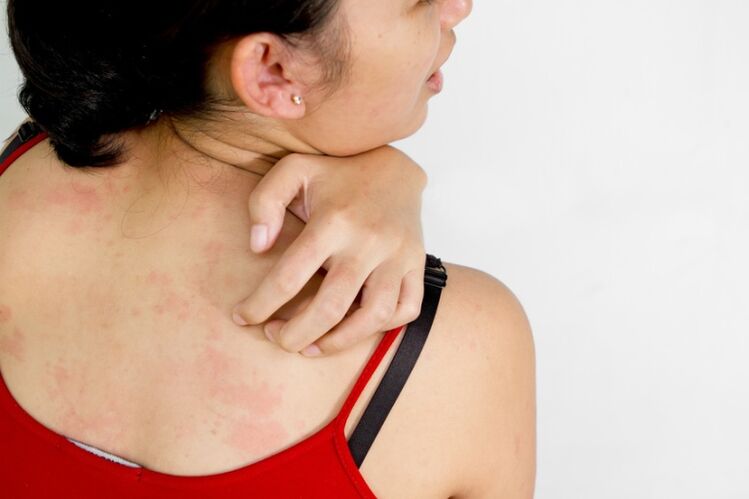
Psoriasis is a systemic disease that affects more than the skin and nails. It affects the joints, tendons and the spine, the immune, nervous and endocrine systems.
But still, the main manifestations of the disease occur on the skin. The name scaly lichen quite accurately reflects the symptoms of psoriasis. The first manifestations are often pink or bright red papules of the correct rounded shape, covered with scales - psoriatic plaques. They are located symmetrically, primarily on the surfaces of the extensors, lower back, and scalp. But they can affect any part of the skin and genital mucous membranes. Their size ranges from a few millimeters, in the initial stages, to ten centimeters or more.
Depending on the characteristics of the rash, suchforms of psoriasis:
- Sting Psoriasis - the size of the elements is less than the head of a pin.
- Guttate psoriasis - the papules are teardrop shaped and grow to the size of a lentil speck.
- In piece psoriasis - the plaques grow to 3-5 mm and have rounded edges.
They also distinguish the shapes of the eruption, when its elements are in the form of rings, arches and garlands, geographical maps with irregular edges.
The papules are covered with a scaly coating that can be easily removed. It is made up of keratinized cells of the epidermis. Psoriatic plaques start to scale up from the center, then the plaque spreads to the edges. Its loose and light appearance is due to the fact that the keratinized cells are permeated with spaces filled with air. A pink ring can form around the elements - it is an area of inflammation, an area of plaque growth. The skin around the elements of the rash is not changed.
Scalp psoriasisrepresents psoriatic plaques that rise considerably above the surrounding skin. They are densely covered with scales resembling dandruff. In this case, the hair is not affected. Rashes can occur not only under the hair, but also on smooth skin, on the neck and behind the ears. Such changes are explained by the active division of keratinocytes in the affected areas.
Psoriasis of the feet and palmscauses a strong thickening of the stratum corneum of the skin in these areas of the body. The skin becomes thick, rough. Often cracks enter it. This is caused by intensive cell division, which multiplies 8 times faster than usual, but is not cleared in time from the skin surface.
Psoriasis of the nailsdiffers in a variety of symptoms. But the most important are two main types of nail plate damage:
- By the type of "thimble". Small holes form on the nail plate, similar to needle stick marks.
- By the type of onychomycosis. The lesions look like nail fungus. The nails thicken, change color, flake off. A psoriatic papule surrounded by a red border is visible through the nail plate. Looks like a stain of oil shining through the nail.
The symptoms and signs of psoriasis depend on the stage of the disease, which are replaced cyclically throughout the year. So, most patients have a disease of the "winter" type, when the exacerbation occurs in the autumn-winter period. An improvement in the condition in summer is due to the fact that ultraviolet light from the sun has a therapeutic effect. But some patients suffer from the "summer" type.
There are such stages in the course of psoriasis:
- gradual - the appearance of new elements, the active growth of existing plaques, the implicit pink growth area around them, intense peeling and itching.
- stationary - stopping the growth of papules, the absence of new rashes, thin folding of the upper layer of the skin around the psoriatic plaques.
- regress - the absence of desquamation, the disappearance of plaques and the appearance in their place of areas of pigmentation, indicate the attenuation of the process.
What do skin rashes associated with psoriasis look like?
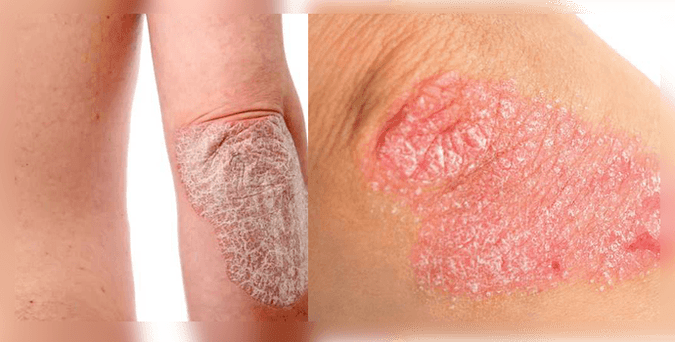
Each organism is individual and reacts differently to illness. Therefore, the nature of the rash can be very varied. This explains the variety of forms and types of psoriasis.
However, for most people, the symptoms of psoriasis are similar. These are red spots - psoriatic plaques, rising 1 to 3 mm above the level of healthy skin. Their appearance is caused by the fact that the cells of the surface layer of the skin - keratinocytes, divide very actively, not having time to mature and turn into full-fledged epithelial cells. Due to this increased pathological growth, some areas of the skin thicken. This is because the immune cells release chemicals that cause the skin to become inflamed.
From above, the plates can be covered with a gray, silver or yellowish flower, which resembles paraffin. Therefore, they received the name of "paraffin lakes". These are keratinized epithelial cells whose rejection is impaired and they accumulate on the surface of the affected skin area.
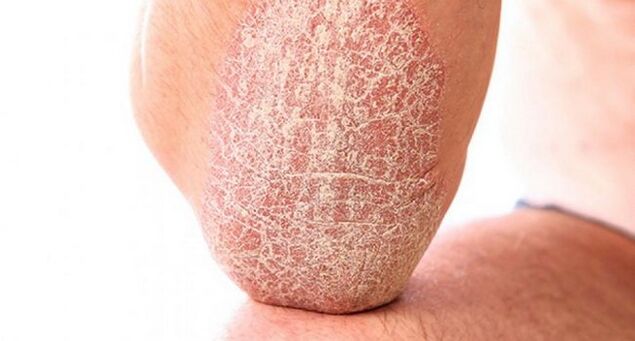
The spots are scaly, warmer than the rest of the skin, and can grow to a large size. Often the patient feels severe itching in this place. This is due to the fact that against the background of the inflammatory process, a cascade of neuro-reflex reactions and an allergic reaction occur.
Papules are another type of element. These are small parts of a rash that look like a tubercle. The size is about 1mm. In the middle there is no cavity filled with contents. They are often located on the knee and elbow joints. They remain even during times when the disease recedes.
During exacerbations, the elements of the rash gradually increase in size and merge with neighboring plaques. During periods of improvement (remission), the spots begin to lighten from the middle. They gradually take the shape of a ring and can dissolve completely. After the plaques, a trace remains on the body - pigmentation. It can be significantly lighter or darker than the surrounding skin. Once a person is tanned, the skin tone is usually even.
What do nail lesions look like in psoriasis?
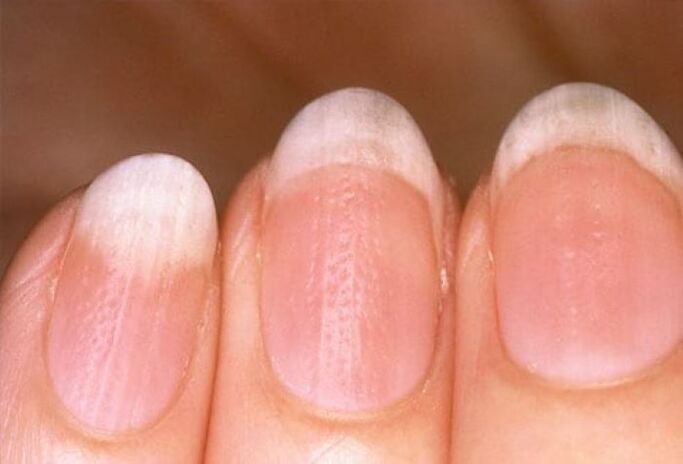
Nail psoriasis is similar to a fungal infection of the nail plate. For a correct diagnosis, it is necessary to conduct a laboratory analysis. The changes can affect only one nail or all at once and are very diverse. They occur in 10 to 15% of patients. Nail damage is often accompanied by joint pain caused by psoriasis. In this case, there may not be a rash.
Psoriasis of the nail has several stages:
- depressed stitches - nail thimble
- recessed longitudinal grooves
- transverse compression in the center of the nail, these early signs are associated with damage to the root of the nail - the nail matrix
- "Oil spots" irregularly shaped pink spots that appear across the nail - this is the buildup of serous fluid under the nail
- the nail becomes dull, cloudy, yellow, and thickened due to circulatory disturbances
- the nail plate takes on the appearance of a bird's claw, which is accompanied by pain. This is because the process captures nerve endings.
Nail lesions start from the edge and gradually move to the root, covering the entire surface. Microcirculation disorders cause the nail to become cloudy and its color to change from yellow to bluish.
If you find similar symptoms in yourself, do not diagnose yourself. Similar changes can be caused by other reasons: fungus, trauma, and impaired blood supply.
Is psoriasis contagious?
This question is often asked by those who have just been diagnosed with the disease and the knowledge of the patient. Scientists give it an unequivocal answer. Psoriasis is not contagious, and a sick person is absolutely safe for others. This is because psoriasis is not caused by a virus or bacteria, but by aggressive white blood cells. These own immune cells, for unknown reasons, attack the skin cells, causing the skin to become inflamed. The result of this process is rashes and thickening of the skin in some places (psoriatic plaques).
How is psoriasis treated?
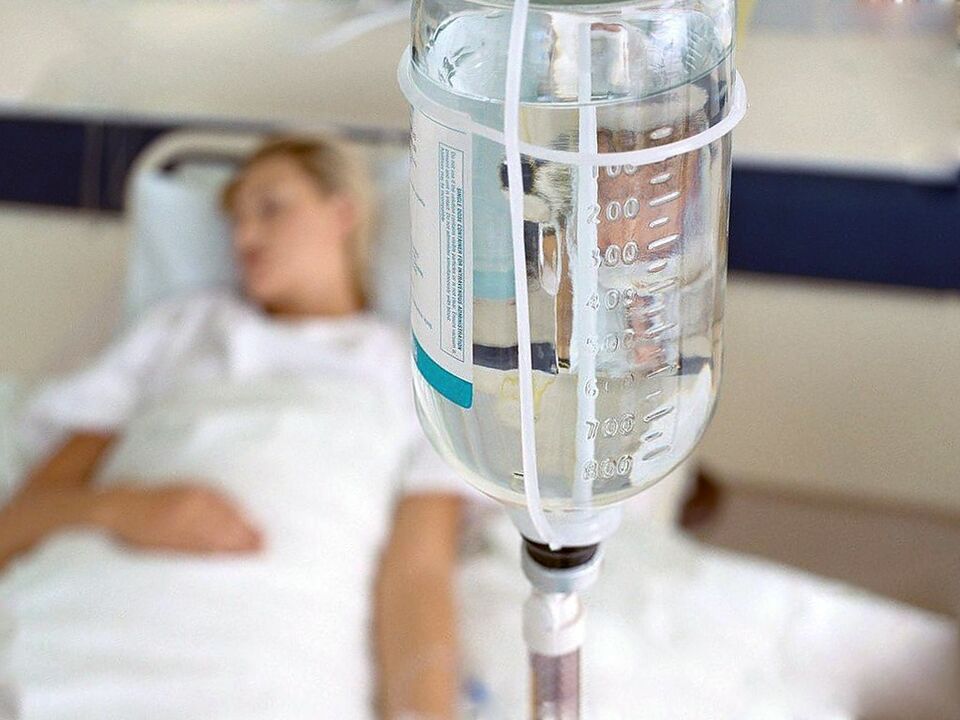
Treatment for psoriasis depends on the form and stage of the disease and sensitivity to medications. Traditional medicine focuses on the use of drugs. Treatment begins with local preparations which act on the affected skin. Thus, they try to avoid the side effects that occur while taking oral medication. More details on the use of local remedies will be described below. Let us now focus on the pills and capsules.
There is a technique where, first, the patient is offered milder drugs with fewer side effects. If they are not effective, they are replaced by more powerful ones, and so on. Even in the case where the treatment is adapted to the patient, after a certain time it is changed. The fact is that the body gradually gets used to the drug and its effect wanes.
Oral systemic drugs are very effective. They are prescribed for moderate and severe stages of the disease. They even help patients for whom treatment by other means has not given a positive result. However, they have significant drawbacks - they can cause serious side effects, and after the removal of these funds, the condition worsens again.
| Drug group | Dosage form and effect of the drug on the body |
| Retinoids - derivatives of vitamin A | Influences the maturation of the surface layer of the skin and eliminates disturbances of this process caused by psoriasis. Form of release - capsules. Dosage according to the scheme, depending on the stage, 30-75 mg / day. Reduces the rate of keratinocyte division, promotes normal maturation and differentiation of cells. Available in capsules. The daily dose is 25 to 50 mg. |
| Immunosuppressants - drugs that reduce the activity of the immune system | Reduces the activity of T lymphocytes, which cause increased division of skin cells. Sterile solution in ampoules. The initial dose when given into a vein is 3 to 5 mg / kg per day, for oral administration 10 to 15 mg / kg per day. |
| Medicines for the treatment of malignant tumors (Cytostatics) | Inhibits the excessive growth and reproduction of atypical cells of the epidermis. Available in tablets. Assign 2. 5 to 5. 0 mg orally, 2-3 times a day, 1 time per week. |
Physiotherapy treatments for psoriasis are very effective. They provide significant relief to patients, stop the progression of the disease, and in some cases serve as a safe substitute for medications.
| Physiotherapy method | Effects on the body |
| PUVA therapy or photochemotherapy | Combination of long-wave ultraviolet radiation and an internal photosensitizer. The course includes 20-30 procedures. The method is based on the fact that UV rays penetrate deep into the skin. The photosensitizer inhibits the DNA synthesis of skin cells and the rate of their division. For processing, special facilities or cabins are used. |
| Selective phototherapy (S. F. T) | Irradiation of the skin with ultraviolet rays with a wavelength of 280-320 nm. The course includes 15-35 procedures. A special cabin is needed for therapy. |
| Monochromatic UV treatment | Exposure to each focus separately with a laser or UV radiation source lamp. It allows to irradiate the foci even in the places difficult to access, without affecting the healthy skin. It is prescribed in cases where less than 10% of the skin is affected. The course of treatment is 15-30 procedures. |
| Laser therapy | For the treatment of rashes, laser radiation of different wavelengths is used. The laser promotes the rapid resorption of psoriatic plaques, protects against the appearance of scars in their place. The doctor determines the number of procedures individually for each patient. |
| Electric sleep | The procedure is performed on a device based on a mild effect on the brain with weak electrical impulses. Duration 20-60 minutes. The number of procedures is 10-12. Electrosleep has a calming effect. As a result, the activity of the nervous system is normalized, the plaques begin to dissolve, and a period of well-being begins more quickly. |
| Magnetotherapy | Treatment with magnetic fields has a beneficial effect on the general condition. Itching and inflammation of the skin, swelling and pain in the joints decrease, the psycho-emotional state improves. The Betatron device is used for treatment. The duration of the procedure is 20 minutes. Number per course 10-15. |
| Ultrasound therapy | It is used as a pain reliever, antipruritic and decongestant. Promotes the resorption of scars. The procedure can be combined with the administration of drugs (phonophoresis). The exposure time to one area is 15 minutes. To obtain a therapeutic effect, 7 to 14 sessions are necessary. |
| Hyperthermia | Heat the fabrics to a temperature of 40 degrees using special pillows with a thermal mixture. This effect on the body normalizes the functioning of the immune system and reduces aggression on the skin. The duration of the procedure is approximately 2 hours. Their number is determined by the doctor. |
| Bee venom treatment | The substance is introduced into the body using an electrophoresis device or ultrasound. An anti-inflammatory, absorbable and antipruritic effect is obtained. The metabolism is normalized. The minimum number of procedures is 10. |
It is very important for people with scaly lichen to diet. Eating disorders can make the disease worse. The menu should be rich in vitamins and at the same time simple. It should give the intestines and liver rest, and also not allergenic the body.
| Authorized products | Prohibited foods |
| Vegetables (pumpkin, watermelon, beets, carrots, potatoes, radishes) | Animal fats |
| Fruits (apricots, peaches, apples), juice | Alcohol |
| Berries (except red berries: strawberries, raspberries, currants) | Fat meat (pork, duck) |
| Fresh herbs | Smoked meats |
| Lean meat (veal, beef, rabbit, turkey) no more than 200 g per day | goldfish |
| Cheese, cottage cheese, dairy products | Soft drinks and coffee |
| Nuts | Eggs |
| Low-fat fish varieties | Ice creams and milkshakes |
| Seaweed | Minimum amount of confectionery and sugar |
| Whole wheat bread | Butter and puff pastry |
To cleanse the body of toxins and metabolic products, it is necessary to perform fasting days twice a week. They recommend kefir, apple, vegetables.
Which ointments are effective in treating psoriasis?
The use of ointments for psoriasis brings the greatest effect compared to other external preparations. The ointment components do not stay on the surface of the plaque, but soften the scales and get inside the skin.
There are a large number of ointments available to treat psoriasis. In the early stages, namenon-hormonal ointments.
In case the treatment did not give the desired effect, then prescribehormonal ointments. . . Treatment begins with lighter medications that have minimal side effects. If no improvement has been achieved, stronger ointments containing glucocorticoids are prescribed.
| Ointment name | Drug action | Side effects |
| Weak ointments | Suppresses the increased activity of leukocytes, prevents their movement in the skin, eliminates the feeling of tightness and itching. | Swelling of the skin, itching, redness. |
| Moderate ointments | It has anti-inflammatory, anti-allergic, anti-edematous, antipruritic effects. Suitable for patients with exuding forms of psoriasis, reduces bleeding. Apply in a thin layer on limited areas 2 to 3 times a day. The treatment lasts 10-14 days. | Steroid acne, skin atrophy and stretching, burning, itching, hypopigmentation. |
| Strong ointments | Local anti-inflammatory, antipruritic and anti-allergic agent. Reduces skin moisture. Apply to the affected area 2-3 times a day for up to two weeks. Used during an exacerbation. | Skin atrophy. |
| Very strong ointments | It has a strong antipruritic and anti-allergic effect. Slows down the processes of cell division and keratinization. Apply 1-2 times a day for no more than two weeks per course. | Acne, hair loss, skin atrophy. Do not use for pustular and generalized plaque psoriasis. |
Pharmaceutical companies produce many drugs in the form of ointments. The doctor individually selects the drug for the patient and, if necessary, replaces it with a stronger one.
Remember that in any case with psoriasis you should not ignore doctor visits. After all, this disease can hide the initial stage of skin cancer.
Choosing a treatment regimen for psoriasis is a long process that involves a lot of trial and error. Don't despair if you can't find "your" medicine right away. Remember that many people achieve lasting improvement when the disease does not return for years. You can do it too!























